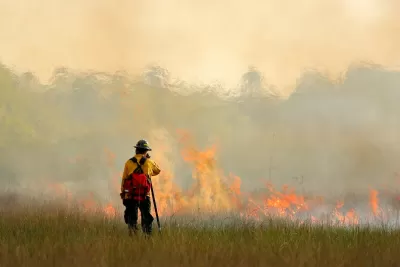Federal firefighting forces, already underresourced, are being slashed even as wildfires become a year-round problem.

Federal funding and staff cuts are undermining state and federal agencies’ ability to prevent and fight wildfires, according to reporting by Mark Olalde for Pro Publica.
In the wake of devastating fires in the Los Angeles region, state and local agencies in California and across the country need support more than ever. Yet “The uncertainty has limited training and postponed work to reduce flammable vegetation in areas vulnerable to wildfire. It has also left some firefighters with little choice but to leave the force, their colleagues said.”
After recent cuts, some seasonal workers’ contracts were suspended, while firefighters headed to support a major prescribed burn in Florida were turned back. “Prescribed burns help prevent catastrophic wildfires by clearing vegetation that serves as fuel, and the meticulously planned 151,434-acre Florida fire — to cover more than six times the land area of nearby Miami — was also meant to protect a Native American reservation and improve ecological biodiversity.” Roughly two-thirds of prescribed burns in the nation are in the Southeast, where they help minimize fuel for naturally occurring fires and promote biodiversity.
Federal firefighter forces already faced challenges in hiring and retaining workers due to low pay and high-risk work. Now, agencies are unsure how to proceed, or when — and if — they will have access to resources again.
“All this comes as wildfires are growing larger and more catastrophic,” Olalde points out. “The area of land burned annually over the past decade was 43% larger than the average since the federal government began tracking it in 1983, according to data from the National Interagency Coordination Center.”
FULL STORY: Trump’s funding cuts leave the nation vulnerable to catastrophic wildfire

Maui's Vacation Rental Debate Turns Ugly
Verbal attacks, misinformation campaigns and fistfights plague a high-stakes debate to convert thousands of vacation rentals into long-term housing.

Planetizen Federal Action Tracker
A weekly monitor of how Trump’s orders and actions are impacting planners and planning in America.

In Urban Planning, AI Prompting Could be the New Design Thinking
Creativity has long been key to great urban design. What if we see AI as our new creative partner?

King County Supportive Housing Program Offers Hope for Unhoused Residents
The county is taking a ‘Housing First’ approach that prioritizes getting people into housing, then offering wraparound supportive services.

Researchers Use AI to Get Clearer Picture of US Housing
Analysts are using artificial intelligence to supercharge their research by allowing them to comb through data faster. Though these AI tools can be error prone, they save time and housing researchers are optimistic about the future.

Making Shared Micromobility More Inclusive
Cities and shared mobility system operators can do more to include people with disabilities in planning and operations, per a new report.
Urban Design for Planners 1: Software Tools
This six-course series explores essential urban design concepts using open source software and equips planners with the tools they need to participate fully in the urban design process.
Planning for Universal Design
Learn the tools for implementing Universal Design in planning regulations.
planning NEXT
Appalachian Highlands Housing Partners
Mpact (founded as Rail~Volution)
City of Camden Redevelopment Agency
City of Astoria
City of Portland
City of Laramie





























